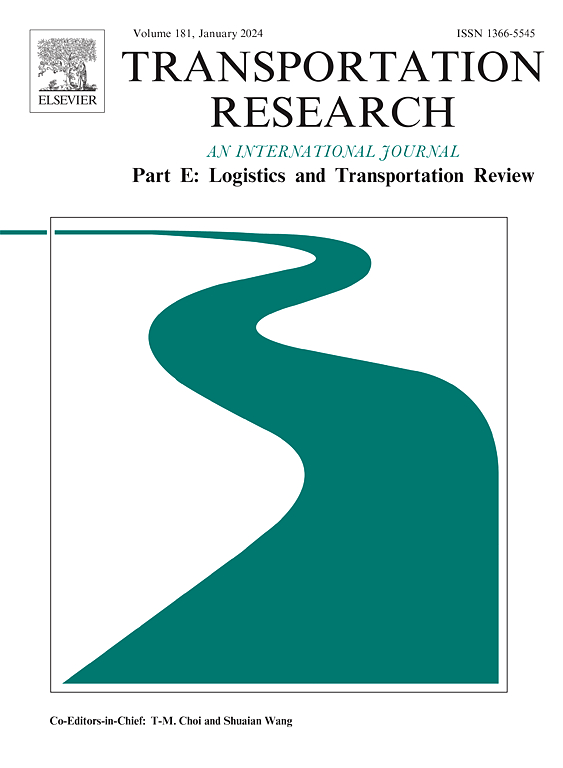资金约束下供应链的合作融资模式
IF 8.3
1区 工程技术
Q1 ECONOMICS
Transportation Research Part E-Logistics and Transportation Review
Pub Date : 2025-04-29
DOI:10.1016/j.tre.2025.104132
引用次数: 0
摘要
随着零售商融资需求的增加和银行的风险规避,group lending (GL)这一继信贷融资(credit financing, CF)之后的新兴银行贷款模式受到了广泛关注。group lending要求零售商申请集体贷款,承担连带责任,银行设定统一的利率。为了研究GL如何影响供应链中的运营决策和利润,我们考虑两个资金受限的零售商,他们通过CF从一个供应商采购,或者从风险厌恶的银行获得GL贷款。我们证明,与CF相比,GL使零售商在融资上合作,在产品销售上竞争,这导致合作竞争,促使零售商或由于融资成本的降低而增加订单和贷款额,或由于合作的约束而减少订单和贷款额。此外,GL可能对供应链成员有利或不利,这取决于批发价格和零售商未来的收入。令人惊讶的是,较高的银行风险厌恶会扩大CF和GL之间的融资成本差距,这可能使零售商更倾向于融资成本高于GL的CF。我们还发现,当批发价格是内生的时,GL可能会恶化或缓解双重边缘化问题,并可能通过部分连带责任进行帕累托改进。本文的研究为零售商的融资模式选择和市场管理者的供应链管理提供了管理启示。本文章由计算机程序翻译,如有差异,请以英文原文为准。
Cooperative financing mode in a capital constrained supply chain
The increased financing demand on retailers and the risk aversion from banks have brought extensive attention on group lending (GL), the emerging bank loan mode in addition to credit financing (CF), which requires the retailers to apply for a group loan with joint liability and the bank to set uniform interest rates. In order to investigate how GL impacts the operational decisions and profits in the supply chain, we consider two capital-constrained retailers who source from one supplier via the CF or GL loan from a risk-averse bank. We demonstrate that compared with CF, GL enables the retailers to cooperate on financing and compete on product sale, which induces a co-opetition that motivates the retailers to either increase order and loan amounts due to the reduction of financing cost or reduce the order and loan amounts due to the constraint of cooperation. Moreover, GL may benefit or hurt the supply chain members, contingent on the wholesale price and the retailers’ future revenue. Surprisingly, a higher bank risk aversion that widens the financing cost gap between CF and GL may enable the retailers to prefer CF that induces higher financing costs than GL. We also reveal that when wholesale price is endogenous, GL might deteriorate or alleviate the double marginalization issue, and it could be Pareto-improved by partial joint liability. Our research provides managerial insights for the retailers’ financing mode choices and the market managers’ supply chain management.
求助全文
通过发布文献求助,成功后即可免费获取论文全文。
去求助
来源期刊
CiteScore
16.20
自引率
16.00%
发文量
285
审稿时长
62 days
期刊介绍:
Transportation Research Part E: Logistics and Transportation Review is a reputable journal that publishes high-quality articles covering a wide range of topics in the field of logistics and transportation research. The journal welcomes submissions on various subjects, including transport economics, transport infrastructure and investment appraisal, evaluation of public policies related to transportation, empirical and analytical studies of logistics management practices and performance, logistics and operations models, and logistics and supply chain management.
Part E aims to provide informative and well-researched articles that contribute to the understanding and advancement of the field. The content of the journal is complementary to other prestigious journals in transportation research, such as Transportation Research Part A: Policy and Practice, Part B: Methodological, Part C: Emerging Technologies, Part D: Transport and Environment, and Part F: Traffic Psychology and Behaviour. Together, these journals form a comprehensive and cohesive reference for current research in transportation science.

 求助内容:
求助内容: 应助结果提醒方式:
应助结果提醒方式:


